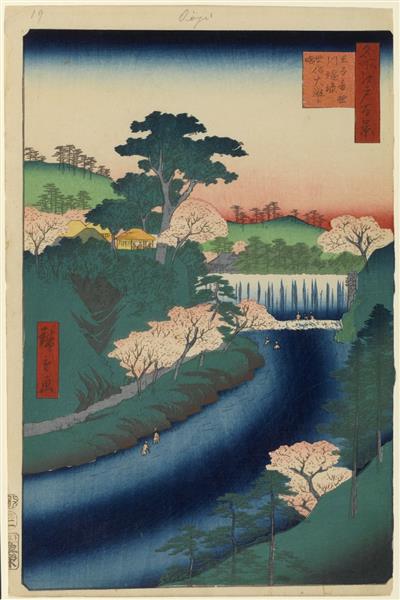Description
The painting "Dam on the Otonashi River at Ōji, known as The Great Waterfall" (1857) by Utagawa Hiroshige is an emblematic work that encapsulates the mastery of one of the greatest Japanese ukiyo-e artists. Framed within the series of paintings that the artist dedicated to landscapes of Japan, this work not only stands out for its aesthetic beauty, but also for the sophistication of its composition and use of color, distinctive characteristics of Hiroshige's style.
The scene focuses on the depiction of a waterfall, which is rendered with vibrant dynamism through the use of fluid lines and a variety of blues and whites that simulate moving water. Hiroshige employs a gradient of hues to convey the force and movement of the falling water, capturing the dramatic essence of this natural phenomenon. The waterfall acts as the central axis of the composition, framed by a series of stylized pine trees that add verticality and depth to the image. This contrast between the force of the water and the stability of the trees reflects the duality present in nature, a recurring theme in the artist’s work.
The work also features an interesting play of light and shadow. Hiroshige uses a darker tone in the shaded areas behind the waterfall, creating an interesting contrast that highlights the luminosity of the illuminated areas. This effect not only enriches the visual representation, but also brings an emotional dimension to the work, suggesting the inescapability of the passage of time and the persistent transformation of nature.
In terms of characters, the painting includes human figures at the bottom, interacting with the landscape. These individuals, though tiny in comparison to the majesty of the waterfall, are crucial in giving the work scale and context. The inclusion of human figures is a regular feature in ukiyo-e, often to evoke a sense of narrative and everyday life in the natural setting.
“Dam on the Otonashi River” fits within the broader context of ukiyo-e, an artistic movement that flourished during the Edo period (1603-1868) and sought to capture the ephemeral beauty and pleasure in everyday Japanese life. Through his innovative use of perspective and focus on landscapes, Hiroshige helped define and refine ukiyo-e, becoming a forerunner in the depiction of the Japanese landscape. His attention to detail and ability to evoke emotion through nature have influenced generations of artists both in Japan and abroad.
In conclusion, “Dam on the Otonashi River at Ōji” is a work that transcends its time, rich in symbolism and technique. It represents not only Hiroshige’s skill as a master of ukiyo-e, but also the deep connection between humanity and nature that permeates his work. When looking at this painting, the viewer is invited to reflect on the beauty of the natural world, its perpetuity and its fragility, a message that remains relevant today.
KUADROS ©, a famous painting on your wall.
Hand-made oil painting reproductions, with the quality of professional artists and the distinctive seal of KUADROS ©.
Painting reproduction service with satisfaction guarantee. If you are not completely satisfied with the replica of your painting, we will refund 100% of your money.

